Just 10-15 years ago, dentists could not even imagine how a badly damaged tooth could be restored without using a crown. However, medicine does not stand still, and this is especially true for the dental industry.
Every year, more and more interesting offers appear on the market for these services, with the help of which you can achieve beautiful smile, having spent minimal amount time and medical efforts. In addition, in most cases it does not hurt at all.
Is it always possible to restore a damaged tooth?
Today tooth extension various methods used everywhere. Experienced doctors can not only correct cosmetic defect, but also to give the smile an incredibly beautiful aesthetic appearance.
As a rule, dentists suggest tooth augmentation in the following cases:
- chipping of part of the tissue or its loss as a result of the development of caries;
- the presence of cracks and other damage to tooth enamel;
- curvature of one or more teeth;
- mechanical injuries that damage the integrity of bone tissue;
- discoloration of tooth enamel;
- wear and tear of bone tissue due to age-related changes;
- tartar;
- formation of cracks;
- development of caries, which is located under a previously placed filling. In this case, the bone tissue begins to rot from the inside. The back teeth, especially the chewing ones, are more likely to be damaged by similar injuries.
Despite the fact that extension, or restoration, is unusual useful technique, there are certain contraindications to the use of this method. First of all, it should be taken into account that it is impossible to grow bone tissue in an area that cannot be completely isolated from moisture. In such a situation, the composite substance simply will not be able to dry and consolidate as necessary.
In addition, when working on new material, you should be especially attentive to your health. Individual intolerance to composite substances that are used in extensions is quite rare, but still occurs. In addition, most people who are susceptible allergic reactions On similar materials, they leak quite heavily.
It is for this reason that dental augmentation is almost never done on pregnant women. Expectant mothers become unusually sensitive while expecting a baby, and any foreign substance can cause a completely unexpected reaction in them.
Finally, an indirect contraindication for restoration is bruxism.

In the case where the surface is damaged due to this unpleasant habit, it is pointless to restore it, because in the near future it will chip again. Before you tidy up your smile, you need to understand the reason for this phenomenon.
In most cases, dental clinics use a method of tooth extension called composite restoration. However, there are other varieties of this method, which, by and large, are a combination of this technique and prosthetics.
How to grow a tooth onto the root if there is no bone tissue left at all?
Restoration with composite materials is used only in cases where at least 2/3 of the bone tissue remains intact. Meanwhile, quite often there is a situation when it is simply gone, and only the root remains of the tooth. In this case, none of the patients will want to part with a healthy root, so modern dentists, using microprosthetics techniques, build a new tooth directly onto it.
For this purpose, an artificial individual filling, or stump inlay, is made. This measure prevents changes in the bite and, moreover, is a very reliable way to restore a damaged tooth. In addition, a metal-ceramic or porcelain crown is usually fixed onto the stump inlay, which does not change color and other characteristics during use.
In addition, in modern dentistry, pins are quite widely used to build teeth. This part is a permanent prosthesis and consists directly of a pin and a crown part. The most popular type of such prostheses are anchor pins, which are fixed in the root area using certain chemicals and cement.

If any complications arise, removing the anchor pin will not be difficult even for a novice dentist, because it is very clearly visible on an x-ray.
In situations where more durable fixation is required, fiberglass pins are often used, which, however, are very difficult to remove during development. inflammatory process.
Regardless of the type of prosthesis, its installation consists of the following steps:
- root canal preparation;
- introduction required material into the root canal entering the bone tissue. This is done to ensure that the prosthesis is as stable as possible;
- fixing the pin with a seal;
- covering the pin with an artificial crown.
Is it possible to build up dental bone tissue using folk remedies, and how to do it?
If your teeth are decaying too often, you need to rebuild your bone tissue. To do this, you should contact a qualified dentist who will carefully examine your oral cavity and will give appropriate recommendations that are best suited to your situation.
Along with traditional medicines, folk remedies therapy is often used to improve the condition of the oral cavity.
In particular, the following recipes will help you prepare useful medicines:

- Place 7 tablespoons of the herb in a small saucepan, pour 400 ml of boiling water over it and immediately put on the fire. Bring the broth to a boil, reduce heat and simmer for 2 minutes. The herb prepared in this way should be squeezed and crushed, then add 25 grams of grated horseradish, 20 grams of sour cream and a small pinch of salt. Mix all ingredients thoroughly and consume the prepared mass at one time. This “salad” must be eaten every evening;
- Break 5 chicken eggs and add 2 tablespoons of preheated honey to them. Place the resulting mixture in a cool, dark place for 5 days. Dry the shells of these eggs, then grind them into powder and pour in natural juice squeezed from 5 whole medium-sized lemons. After 5 days, combine these two masses, add 50 ml of Cahors or cognac to them and mix all the ingredients thoroughly. Take the resulting medicine one tablespoon once a day. After the composition runs out, you need to take a break for 3-4 days and then repeat the course of treatment again;
- in 100 ml warm water dissolve a small piece of mummy well. Take this solution morning and evening, one tablespoon at a time, for 3 weeks. Repeat the course of treatment using this folk remedy possible up to 3 times a year;
- thoroughly wash raw egg and, without breaking it, place it in a jar small size, which can be tightly closed with a lid. In a separate bowl, combine 125 ml of cognac and the same amount of natural lemon juice. Mix this liquid well and pour it over the egg. After this, close the vessel and place it in a warm, dark place for 2 weeks. This time is usually enough for the calcium salts to go into solution. After 2 weeks or a little more, you should carefully remove the egg from the jar and take the medicine thus obtained 2 times a day, a teaspoon.
Often people who are about to restore the dental surface are interested in whether it hurts to build up teeth. Of course, in some cases this method causes painful sensations, but modern anesthesia methods completely eliminate the likelihood of discomfort.
Monitor the condition of your oral cavity, contact your dentist in a timely manner, and you simply will not have the need to build up bone tissue.
Teeth, although they are the hardest tissue in the human body, are at risk of mechanical damage every day.
Destruction occurs due to weak immunity, as a complication after diseases of internal organs.
Doctors face difficult task restore the functional and aesthetic qualities of the dentition. But many patients have no idea what opportunities there are and how much it costs to grow a tooth.
There are specific cases when extensions are indicated for patients. These include:
- chipped pieces of enamel;
- cracks on the tooth surface;
- injury;
- darkening or demineralization of enamel that cannot be whitened;
- erasing the surface layer;
- destruction of the caries plan.
When a person loses part of a tooth or an entire unit, he cannot fully chew food, and such an aesthetic defect can also cause considerable discomfort.
In the recent past, implants saved these cases. Modern materials make it possible to build up damaged tissue and the tooth regains its natural integrity and functionality.
 Today there are the following types of restoration in dentistry:
Today there are the following types of restoration in dentistry:
- filling;
- extension with composite materials;
- , lumineers;
- crowns;
- pins;
- tabs.
Filling is the most common and easiest way to restore the integrity of the tooth body.
Modern fillings are a super-strong composition that takes root well, completely merging with the bone tissue. Filling compounds allow you to vary and select the desired color shades.
Extension procedure
Extension – innovative technology restoration in dentistry. This procedure is not so painful for patients, and allows them to save their teeth even in cases where only one root remains.
A person with straight, healthy teeth smiles and talks without embarrassment, feels confident, and has no difficulty chewing.
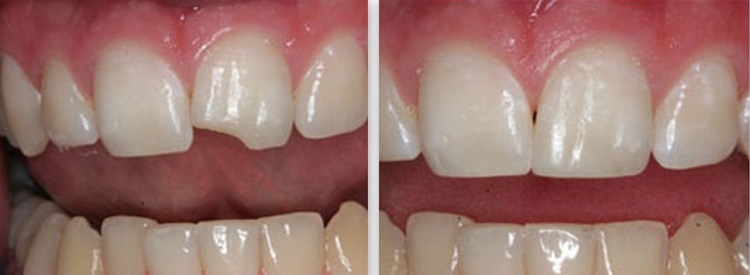
Dental augmentation allows you to completely restore damage if it affects no more than 30% of the crown surface
When is extension needed? The tooth may wear out over time, have cracks and chips from mechanical shock or chewing hard food. Carious processes also destroy enamel and denta.
Sometimes one or two teeth grow unevenly. Then they can be sharpened and extended to the correct shape.
If whitening or cleaning fails, a good result can be achieved by building up the entire contour of the tooth.
Contraindications to the procedure
 Bruxism – teeth grinding at night causes the enamel to wear away. First you need to get rid of the cause, then move on to restoring the integrity of the teeth.
Bruxism – teeth grinding at night causes the enamel to wear away. First you need to get rid of the cause, then move on to restoring the integrity of the teeth.
You cannot use extensions if you are allergic to the materials and compositions used in the procedure.
Using photopolymers
The dentist uses this method of restoration for minor irregularities in the shape of the tooth: a gap between the teeth, a small chip.
For this, polymers are used - composite substances, the hardening of which is carried out under the light of a special lamp. That's why they are called photopolymers.

The use of photopolymers allows you to fill damaged areas after caries, as well as give the crown its original appearance
This material is capable of taking any given shape (it is flexible and plastic), and after hardening it is not inferior in strength to natural enamel. It is sometimes used as protective covering weak enamel, applying to the entire surface of the crown.
The process of using photopolymers is complicated by the fact that the surface must be completely isolated from moisture from exhaled air or saliva.
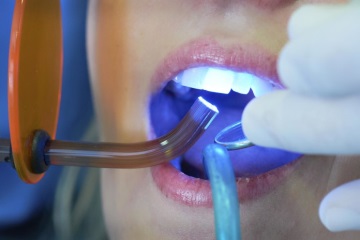 If there is caries, its consequences are first eliminated and treatment with a drill is applied.
If there is caries, its consequences are first eliminated and treatment with a drill is applied.
Anesthesia is possible if necessary. The material is applied in several layers, each of which hardens under a lamp.
Finally, the tooth is precisely shaped and ground and polished.
Extension on a pin
If the root is healthy and the “ground” part is lost, the tooth can be restored by inserting a metal pin into the root canal. The shape of the new unit is modeled using a computer. The protruding parts of the rods are surrounded by mortar.
In addition to metal, pins are made of durable glass or carbon fiber. These materials prevent root cracking when inserting the structure.
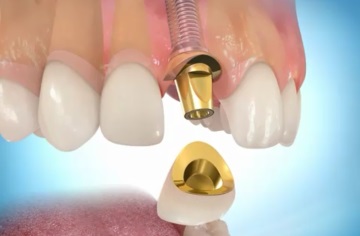 Dentists use 4 types of pins:
Dentists use 4 types of pins:
- plastic – flexible, but short-lived;
- made of carbon material;
- fiberglass;
- anchor - metal, the most durable.
Veneers
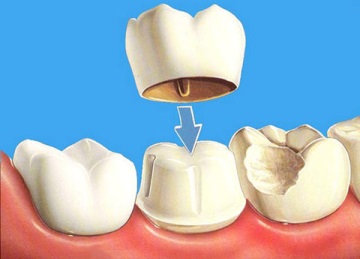 This applies to teeth of any position in the oral cavity: front, back, upper or lower.
This applies to teeth of any position in the oral cavity: front, back, upper or lower.
The nerve is removed before the procedure. Such a tooth loses vital strength, so it is strengthened with a core tab to prevent destruction under the crown.
If there is an inflammatory process in the root zone, it must be cured. Otherwise, the crown will not last long; painful tissue will begin to form underneath it and will have to be removed.
The restoration procedure for modern materials and technologies is possible even in the complete absence of the outer part of the incisor or molar.
The disadvantage of extensions is the unpredictability of the material to change color. Many coatings darken or turn yellow, differing from the natural shade of the rest of the teeth.
A natural crown can not only be restored, but at the patient’s request, the shape and position of the tooth can be changed. When turning and leveling, you can do without the use of braces, which must be worn for months and sometimes years.
Extension requires the artistic taste and precision of movement of the dentist, who undertakes to “sculpt” a new tooth.

The service life of an artificial crown depends on the composition of the material from which it is made
How much does it cost?
Restoration of anterior teeth
It is the incisors that most often chip or crack. They receive the first load from solid food and suffer from mechanical shocks when falling.
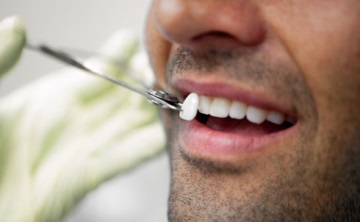 If a person has a standard bite, then over time the front incisors can simply wear down.
If a person has a standard bite, then over time the front incisors can simply wear down.
The nature of the damage can be straight, horseshoe-shaped. Depending on the type of abrasion, the doctor selects a composite material to restore the integrity of the incisor.
How much does it cost to increase front tooth? Depending on the complexity of the work and the materials, the price will range from 2.5 to 20 thousand rubles.
Petal veneers made of ceramics can be glued for 15 thousand rubles per unit.
The cost of extension includes materials, anesthesia, and a set of sterile instruments. The procedure will cost the patient 5,000-6,000 rubles on average. For procedures using composite materials, this price is slightly lower.

Aesthetic restoration eliminates defects such as darkening of the enamel, chips, partial destruction of teeth
Pins are sometimes used for anterior incisors. How much does it cost to grow a tooth on a post? They cost differently depending on the manufacturer. Domestic fiberglass rods are inexpensive, but not durable.
The metal pin is mainly used on the posterior posterior molars. It is impossible to completely hide them on incisors.
Restoration of chewing teeth
The cost of extensions in each clinic may be different. The qualifications of doctors, the cost of equipment and materials, and the complexity of the work are taken into account.
Restoration of chewing molars is rarely complete without the use of pins. How much does it cost to place a pin and build up a tooth? The price of the most “popular” product – a metal anchor pin – is about 600 rubles. If it is replaced with fiberglass, the price will increase 5 times.
Microprosthetics using ceramic or metal inlays will cost 12-13 thousand rubles. One metal-ceramic crown costs from 5 to 11 thousand rubles.
Before restoration work, the doctor will definitely carry out full examination zones using an x-ray.
If necessary, he will prescribe dental and root canal treatment. If an inflammatory process is detected in them, the pulp is completely removed. Treatment also increases the cost of restoration.
As a result, the patient wants to receive not only restoration of tooth function, but also an impeccable aesthetic result. Therefore, save on restorative procedure it makes no sense.
Useful video:
Artistic restoration is carried out in the presence of chips, uneven shape teeth, enamel defects. The dentist-therapist describes in detail the stages of the procedure, and also provides a comparison of prosthetics and aesthetic restoration. The terms “wax-up” and “mock-up” are explained.
As a result various diseases destruction of the crown of the tooth may occur. Trauma can also lead to this. In order to restore a tooth, it is necessary to use various dental technologies, among which tooth augmentation is especially popular.
Prices for teeth extensions
Placing a filling made of a chemical composite 4032 P
Placement of glass ionomer cement filling 3024 P
Installation of therapeutic Ca-containing pads 504 P
Installing an insulating gasket 607 P
Installation of a parapulpal pin 1010 P
Installation of intracanal fiberglass pin 5038 P
Dental extension specialists
Tooth augmentation is an effective method of dentition restoration
Modern dentistry has reached unprecedented heights. So, today it has become possible to solve any problem in the oral cavity in record time, absolutely painlessly, in comfortable conditions and by affordable prices. Latest methods restorations allow not only to give the front teeth aesthetics, but also to restore the chewing functions of the molars. Using techniques such as:
All this allows you to return:
- carious teeth - functionality,
- darkened - whiteness,
- cracked, thinned and improperly positioned - attractive appearance.
As you can see, today there are many ways to grow a tooth. However, the most popular and budget option is considered to be the extension of a tooth to the root.
Several videos about teeth extensions
Extension on a pin is a quick way to restore dentition

Until recently, if only the roots of a tooth remained, it was removed and a prosthesis was placed in its place. Today, using the technique of building a tooth onto a pin, it is possible to restore even a severely damaged tooth.
The advantage of such an extension is minimal a short time procedures (several teeth can be restored in one session) and the maximum long term operation. And what is important is that this method does not require grinding of adjacent units.
A pin is a solid rod that is screwed into bone tissue. After which the composite material is applied. The shapes of pin structures are: cylindrical, cone-shaped, cylindrical-conical and screw. According to the material of manufacture - metal, metal-ceramic and hydrocarbon structures. The latter are distinguished by high strength and excellent aesthetics. This modern version dental restoration.
There are also individual pins that are made taking into account the characteristics of the roots of a particular tooth. They are more reliable than standard designs, allow you to quickly grow teeth and achieve better results.
Indications for tooth augmentation:
- various injuries and pathologies;
- the presence of chips of various shapes;
- when the chewing elements are destroyed;
- in the absence of a crown;
- with advanced caries;
- for securing prostheses;
- old age and others.
Photos with examples of teeth extensions



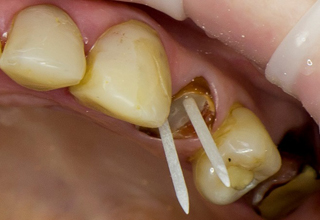

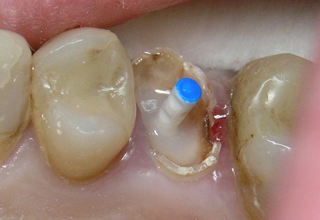
There are a number of reasons why tooth extension on a pin is contraindicated:
- thin walls,
- small root,
- allergic reactions to the material
- and other problems, both dental and general condition health.
Thanks to the extension from the root, it is possible to restore both part of the tooth and restore it completely. All that is required after this procedure is to observe basic oral hygiene every day, otherwise the inflammatory process of the tissues cannot be avoided.
The root extension procedure takes place in several stages.
- Stage 1.
identification of contraindications, examination and preparation of the oral cavity;
- Stage 2.
removal of old fillings and excess hard tissue;
- Stage 3.
implantation of a pin (metal or hydrocarbon) into bone tissue;
- Stage 4.
reconstruction of the tooth using composite material;
- Stage 5.
removing excess filling and polishing the tooth.
Photos with examples of teeth extensions Before and After
 before
before
Chewing teeth are also often subject to destruction, in most cases the cause is caries. After treatment of caries, especially deep ones, large cavities remain, which the specialist fills with filling material after treatment. However, in some cases, only the root and a few thin walls may remain from the tooth, and sometimes even these remain. However, one of the trends in modern dentistry is the use of maximally tooth-preserving techniques. Therefore, if previously a healthy root that had lost its coronal part would most likely be removed, and instead of a tooth a bridge-like prosthesis would be installed, and in best case scenario- implant, today they prefer to preserve the root and restore the coronal part by installing an inlay and a crown.
Unfortunately, in similar cases, some dentists still carry out tooth extension on a pin, which involves installing a metal rod (pin) directly into the root canal and layer-by-layer application of composite materials on it. Once upon a time, this method was a real breakthrough compared to conventional filling, as it made it possible to preserve the root and completely restore the tooth, even in cases where the coronal part was completely lost. However, subsequently, caries often formed around the pin, which provoked further tooth destruction and loss. Therefore, pins are a thing of the past, giving way to more reliable methods.
Teeth extension with crowns
The installation of crowns as tooth extensions is also used in cases where the tooth is not destroyed, but is sufficiently damaged. Installing a crown is one of the effective ways restoration of a broken tooth, this applies to both front and chewing teeth. Crowns are also used in cases where it is not possible to fill a chewing tooth, for example, because the cavity left after caries treatment is too large. This type of fixed prosthetics, such as crowns, is perfect solution in cases where more than 70% of the crown of the tooth is missing.
In modern aesthetic dentistry, ceramic and metal-ceramic crowns are successfully used. The installation process itself takes place in two stages. First, the doctor prepares the tooth (removes infected tissue, grinds down the walls), then an impression is taken, from which a crown for a chewing tooth or a crown for a front tooth is made in a dental laboratory. The second stage is fitting and installation of the finished crown. Modern ceramics, used for the manufacture of inlays and crowns, make it possible to perfectly imitate the texture, color and transparency of natural enamel, as well as select a shade in accordance with the color of neighboring teeth.
How much does tooth augmentation cost?
If we mean tooth extension in the smile zone, then the cost of restoration with composite materials will range from 2,500 rubles to 15,000 rubles per tooth in economy and premium class clinics, respectively. The price of installing ceramic veneers starts from 20,000 per tooth in economic dentistry, and in a VIP clinic the price can reach up to 50,000 rubles per plate. Price for extensions chewing teeth consists of the cost of the tab, a dental crown on it and the work of an orthopedic dentist, which will cost on average from 10,000 rubles to 50,000 rubles, depending on the materials used and the price segment of the clinic.
Visible defects in the front and chewing teeth cause many inconveniences and problems. Firstly, the aesthetic aspect is important, since the incisors are visible to others when talking or smiling. Secondly, chipped or missing parts of a tooth lead to a disruption in the distribution of the load during chewing, which negatively affects the health of the entire oral cavity.
That is why extension of the front teeth, as well as premolars and molars, is very popular and necessary procedure. It’s worth figuring out what indications and contraindications it has? What techniques does modern dentistry use, what are their advantages and disadvantages?
When is a teeth augmentation procedure indicated?
There are many indications for extensions:
Extension methods
There are three main methods used for tooth augmentation:
- use of photopolymer filling material;
- fixation of the pin in the channel with subsequent restoration of the crown;
- installation of veneers
Each of the above methods is effective and reliable, capable of increasing the crown up to normal sizes. The best option the dentist selects after thorough examination and communication with the patient. It is important to contact an experienced specialist who can completely solve the problem and provide long lasting result. Also, the method of restoration depends on the degree of damage and the general condition of the dentition and the oral cavity as a whole.
Using filling material
Doctors began to use photopolymer materials for teeth extensions earlier than anything else. This technique is effective, modern and frequently used. Experts opt for photopolymers, as they provide reliability and complete naturalness.
When the procedure is carried out correctly and with high quality, the extended crowns are stronger than natural ones. Note that even with the restoration of just one unit, it cannot be distinguished from other teeth. Plus it doesn't hurt at all.
Light-curing drugs are used for:
- carious damage to hard tissues;
- cracks in the enamel;
- mechanical chips;
- age-related wear and tear;
- pathological yellowness or pigmentation and other minor damage.
Photopolymers are divided into several types:
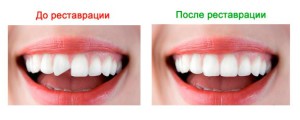
You can grow your front incisor in this way in one session. The dentist prepares the oral cavity, then applies an elastic photopolymer preparation to the damaged units. Several shades are used at the same time, which alternate with transparent layers, which allows you to create the effect of complete naturalness. After exposure to an ultraviolet lamp for 30-40 minutes, it completely hardens. Then the doctor grinds the surface of the restoration filling with a bur, adjusting it to the rest of the row. There are many videos of the restoration process using photopolymers posted online.
On the pin
Pinning is used when there is significant damage to a tooth. Exists important feature To carry out the procedure, the root must be healthy, so pins are used for injuries or caries.
The essence of the extension is to install a pin into the root, which will strengthen it and create a solid base for artificial material. If it is almost completely destroyed without an additional reinforcing frame, the structure will not last long at all (it will break under the constant load of chewing). Pins are made of titanium, silver, steel, hydrocarbon, fiberglass.
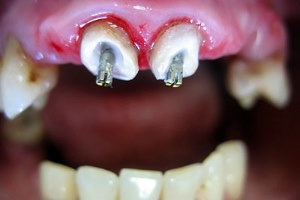 First, the doctor must take microscopic photographs of the root, which will help study its structure and correctly place the pin. Once it is installed, the filling polymer begins to be applied to the solid base. The model for reconstruction is a previously made training model. The material is dried ultraviolet lamp and polished. For complete restoration, a special coating is applied to the surface of the photopolymer substance. protective agent, which according to its characteristics replaces enamel.
First, the doctor must take microscopic photographs of the root, which will help study its structure and correctly place the pin. Once it is installed, the filling polymer begins to be applied to the solid base. The model for reconstruction is a previously made training model. The material is dried ultraviolet lamp and polished. For complete restoration, a special coating is applied to the surface of the photopolymer substance. protective agent, which according to its characteristics replaces enamel.
According to the doctor’s decision, after installing the pin, the tooth extension procedure itself can be carried out using polymers, artificial ceramic or metal-ceramic crowns. The right choice will ensure a long service life of the structure. It is worth noting that the polymer on the pin lasts a long time (about 10 years with proper use) and is highly durable.
Overlays for teeth - veneers or lumineers
Veneers are artificial overlays in the form of plates or petals that can hide all defects and create a perfectly straight smile. Some believe that they are used mainly for cosmetic effect, however, their restoration capabilities and qualities are impressive. It is enough to simply compare photos of teeth before and after correction.
Indications for installation:
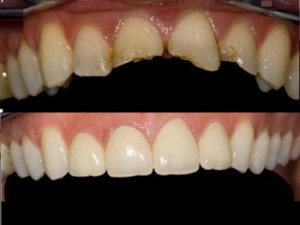
Veneers really solve a lot of problems, and besides, they have an absolutely natural and natural look. The service life of the linings is more than 10 years, and their external qualities are not lost throughout the entire period of operation.
Types of microprostheses:
- Ceramic. They are made from medical ceramics. The thickness of the lining is no more than 0.5 mm. Ceramics has a natural and beautiful appearance, high reflective properties. Over time, it does not stain or fade, so it practically does not require professional care.
- Porcelain. Made from porcelain ceramics. This is a more modern and aesthetic material. It is possible to choose both completely natural shade, and snow-white Hollywood color.
- Zirconium. They consist of ceramics and zirconium dioxide, which gives them special strength. Zirconium stickers last a little longer. The translucent texture of the prosthesis makes it identical to real enamel.
- Composite. A rather outdated type, but widely applicable specifically for forced extensions. Composite substances resemble ordinary fillings. The service life of such linings is 5-7 years, during which time they lose their attractive appearance.
- Lumineers. They are extremely thin - 0.2 mm. Can be made of ceramics, porcelain or zirconium. Due to their thinness, they are not able to hide significant damage, but they last about 20 years. Their installation does not require preparation.
The restoration process with veneers is complex, high-tech and expensive. Several visits to the doctor will be required to preparatory work, preparation (grinding off the top layer of enamel), taking impressions and final installation.
The manufacture of a microprosthesis requires technical training of a specialist and the availability of modern laboratory equipment. However final result justifies all costs.
Is it possible to grow teeth at home?
To the question whether it is possible to build up teeth at home, there is one obvious answer - it is not possible. Restoration of hard tissues can only occur in the clinic. Does not exist traditional methods for restoration.
However, you can restore tooth enamel yourself, provided that it is not completely destroyed. The home remineralization procedure gives good results and completely stops destructive processes. Optimal choice products may become R.O.C.S. from the Medical Minerals series or other gels and varnishes.
Stages of build-up
Despite various ways carrying out the procedure, it consists of certain stages that are mandatory in any case:

Pros and cons of the procedure
The pros or benefits of dental extensions include:
- natural appearance and good cosmetic effect;
- long service life (if worn carefully, the structures last from 5 to 15 years);
- strength and reliability;
- maximum preservation of your own tissues (the procedure involves minor grinding or grinding).
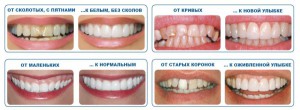 The main disadvantage is the high cost of the service. Restoration is much more expensive than ordinary crowns, but the result is better. Other noticeable shortcomings may appear if the doctor does not have the proper qualifications and experience, or he made a mistake.
The main disadvantage is the high cost of the service. Restoration is much more expensive than ordinary crowns, but the result is better. Other noticeable shortcomings may appear if the doctor does not have the proper qualifications and experience, or he made a mistake.
When does extensions not help?
Dental extensions have contraindications:
- caries and other dental problems (you must first cure all existing diseases);
- bruxism – grinding of teeth during sleep;
- pathological abrasion of teeth;
- children's age (even after changing primary incisors to radical ones, such interventions are undesirable, since the root and crown are in the process of active growth and development);
- predisposition to injury (dangerous professions or hobbies) extreme species sports);
- when not only the crown, but also the root is damaged (in this case, prosthetics are indicated).














